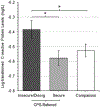Longitudinal associations between attachment quality in infancy, C-reactive protein in early childhood, and BMI in middle childhood: preliminary evidence from a CPS-referred sample
- PMID: 30406720
- PMCID: PMC8815256
- DOI: 10.1080/14616734.2018.1541513
Longitudinal associations between attachment quality in infancy, C-reactive protein in early childhood, and BMI in middle childhood: preliminary evidence from a CPS-referred sample
Abstract
In the current pilot study, we examined whether insecure or disorganized attachment was associated with elevated inflammation (i.e. C-reactive protein [CRP]) in children with histories of child protective services (CPS) involvement, and whether early childhood CRP predicted body mass index (BMI) in middle childhood. Participants included 45 CPS-referred children and 39 low-risk comparison children, for whom we assessed levels of CRP in early childhood (Mean age = 4.9 years). For the CPS-referred children, who were drawn from an ongoing longitudinal study, we had attachment classifications (assessed during infancy with the Strange Situation) and BMI data (assessed during early and middle childhood); these data were not available for the low-risk comparison group. CPS-referred children who had insecure or disorganized attachments during infancy had higher levels of CRP in early childhood than CPS-referred children who had secure attachments, who had similar levels of CRP to low-risk comparison children. Among CPS-referred children, early childhood CRP predicted age 8 BMI, controlling for BMI at age 4. Findings offer preliminary support for the association between attachment quality and inflammation in early childhood, which may have implications for later physical health.
Keywords: Insecure attachment; body mass index; c-reactive protein; inflammation; maltreatment.
Figures
Similar articles
-
Secure attachment predicts lower body mass index in young children with histories of child protective services involvement.Pediatr Obes. 2019 Jul;14(7):e12510. doi: 10.1111/ijpo.12510. Epub 2019 Jan 18. Pediatr Obes. 2019. PMID: 30659782 Clinical Trial.
-
Insatiable insecurity: maternal obesity as a risk factor for mother-child attachment and child weight.Attach Hum Dev. 2015;17(4):399-413. doi: 10.1080/14616734.2015.1067823. Epub 2015 Jul 14. Attach Hum Dev. 2015. PMID: 26169363
-
Attachment state of mind and childhood experiences of maltreatment as predictors of sensitive care from infancy through middle childhood: Results from a longitudinal study of parents involved with Child Protective Services.Dev Psychopathol. 2019 Feb;31(1):113-125. doi: 10.1017/S0954579418001554. Epub 2018 Nov 23. Dev Psychopathol. 2019. PMID: 30466498
-
A meta-analysis of the distribution of preschool and early childhood attachment as assessed in the strange situation procedure and its modified versions.Attach Hum Dev. 2023 Apr;25(2):322-351. doi: 10.1080/14616734.2023.2187852. Epub 2023 Mar 10. Attach Hum Dev. 2023. PMID: 36897065 Review.
-
A birth cohort study of Asian and Pacific Islander children reported for abuse or neglect by maternal nativity and ethnic origin.Child Abuse Negl. 2017 Oct;72:54-65. doi: 10.1016/j.chiabu.2017.07.009. Epub 2017 Jul 27. Child Abuse Negl. 2017. PMID: 28756353 Free PMC article. Review.
Cited by
-
How Does Trauma Make You Sick? The Role of Attachment in Explaining Somatic Symptoms of Survivors of Childhood Trauma.Healthcare (Basel). 2024 Jan 15;12(2):203. doi: 10.3390/healthcare12020203. Healthcare (Basel). 2024. PMID: 38255090 Free PMC article. Review.
-
Relationship Between Family Support, C-Reactive Protein and Body Mass Index Among Outpatients with Schizophrenia.Healthcare (Basel). 2025 Jul 20;13(14):1754. doi: 10.3390/healthcare13141754. Healthcare (Basel). 2025. PMID: 40724779 Free PMC article.
-
How does the social world shape health across the lifespan? Insights and new directions.Am Psychol. 2020 Dec;75(9):1231-1241. doi: 10.1037/amp0000757. Am Psychol. 2020. PMID: 33382288 Free PMC article.
-
Early experience unpredictability in child development as a model for understanding the impact of the COVID-19 pandemic: A translational neuroscience perspective.Dev Cogn Neurosci. 2022 Apr;54:101091. doi: 10.1016/j.dcn.2022.101091. Epub 2022 Feb 21. Dev Cogn Neurosci. 2022. PMID: 35217299 Free PMC article.
-
Attachment orientations and loss adjustment among bereaved spouses.Psychoneuroendocrinology. 2020 Feb;112:104401. doi: 10.1016/j.psyneuen.2019.104401. Epub 2019 Nov 7. Psychoneuroendocrinology. 2020. PMID: 31753327 Free PMC article.
References
-
- Ainsworth MDS, Blehar S, Waters E, & Wall S (1978). Patterns of attachment: A psychological study of the Strange Situation. Hillsdale, NJ: Erlbaum.
Publication types
MeSH terms
Substances
Grants and funding
LinkOut - more resources
Full Text Sources
Medical
Research Materials
Miscellaneous

